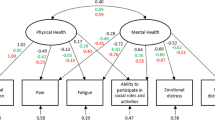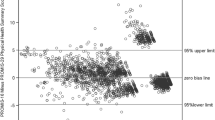Abstract
Purpose
The PROMIS-29 v2.0 profile assesses pain intensity using a single 0–10 numeric rating item and seven health domains (physical function, fatigue, pain interference, depressive symptoms, anxiety, ability to participate in social roles and activities, and sleep disturbance) using four items per domain. This paper describes the development of physical and mental health summary scores for the PROMIS-29 v2.0.
Method
We conducted factor analyses of PROMIS-29 scales on data collected from two internet panels (n = 3000 and 2000).
Results
Confirmatory factor analyses provided support for a physical health factor defined by physical function, pain (interference and intensity), and ability to participate in social roles and activities, and a mental health factor defined primarily by emotional distress (anxiety and depressive symptoms). Reliabilities for these two summary scores were 0.98 (physical health) and 0.97 (mental health). Correlations of the PROMIS-29 v2.0 physical and mental health summary scores with chronic conditions and other health-related quality of life measures were consistent with a priori hypotheses.
Conclusions
This study develops and provides preliminary evidence supporting the reliability and validity of PROMIS-29 v2.0 physical and mental health summary scores that can be used in future studies to assess impacts of health care interventions and track changes in health over time. Further evaluation of these and alternative summary measures is recommended.

Similar content being viewed by others
References
Cella, D., Riley, W., Stone, A., Rothrock, N., Reeve, B., Young, S., et al. (2010). Initial item banks and first wave testing of the patient-reported outcomes measurement information system (PROMIS) network: 2005–2008. Journal of Clinical Epidemiology, 63(11), 1179–1194.
Hinami, K., Smith, J., Deamant, C., DuBeshler, K., & Trick, W. (2015). When do patient-reported outcome measures inform readmission risk? Journal of Hospital Medicine, 10, 294–300.
DeSalvo, K. B., Bloser, N., Reynolds, K., He, J., & Muntner, P. J. (2006). Mortality prediction with a single general self-rated health question. A meta-analysis. Journal of General Internal Medicine, 21(3), 267–275.
Han, P. K. J., Lee, M., Reeve, B. B., Mariotto, A. B., Wang, Z., Hays, R. D., et al. (2012). Development of a prognostic model for six-month mortality in older adults with declining health. Journal of Pain and Symptom Management, 43, 527–539.
Choi, S. W., Reise, S. P., Pilkonis, P. A., Hays, R. D., & Cella, D. (2010). Efficiency of static and computer adaptive short forms compared to full-length measures of depressive symptoms. Quality of Life Research, 19, 125–136.
Hays, R. D., Spritzer, K. L., Fries, J. F., & Krishnan, E. (2013). Responsiveness and minimally important difference for the patient-reported outcomes measurement and information system (PROMIS) 20-item physical functioning short-form in a prospective observational study of rheumatoid arthritis. Annals of the Rheumatic Diseases, 74(1), 104–107.
Hinchcliff, M. E., Beaumont, J. L., Carns, M. A., Podlusky, S., Thavarajah, K., Varga, et al. (2015). Longitudinal evaluation of PROMIS-29 and FACIT-dyspnea short forms in systemic sclerosis. Journal of Rheumatology, 42(1), 64–72.
Katz, P., Pedro, S., & Michaud, K. (2017). Performance of the patient-reported outcomes measurement information system 29-item profile in rheumatoid arthritis, osteoarthritis, fibromyalgia, and systemic lupus erythematosus. Arthritis Care and Research, 69(8), 1312–1321.
Fisher, F., Gibbons, C., Coste, J., Valderas, J. M., Rose, M., & Leplège, A. (2018). Measurement invariance and general population reference values of the PROMIS profile 29 in the UK, France, and Germany. Quality of Life Research, https://doi.org/10.1007/s11136-018-1785-8
Rose, M., Bjorner, J. B., Gandek, B., Bruce, B., Fries, J. F., & Ware, J. E. (2014). The PROMIS physical function item bank was calibrated to a standardized metric and shown to improve measurement efficiency. Journal of Clinical Epidemiology, 67(5), 516–526.
Lai, J.-S., Cella, D., Choi, S., et al. (2011). How item banks and their application can influence measurement practice in rehabilitation medicine: A PROMIS fatigue item bank example. Archives of Physical Medicine and Rehabilitation, 92(10), S20-S27.
Amtmann, D., Cook, K. F., Jensen, M. P., et al. (2010). Development of a PROMIS item bank to measure pain interference. Pain, 150(1), 173–182.
Pilkonis, P. A., Choi, S. W., Reise, S. P., Stover, A. M., Riley, W. T., & Cella, D. (2011). Item banks for measuring emotional distress from the patient-reported outcomes measurement information system (PROMIS®): Depression, anxiety, and anger. Assessment, 18(3), 263–283.
Hahn, E. A., DeWalt, D. A., Bode, R. K., et al. (2014). New English and Spanish social health measures will facilitate evaluating health determinants. Health Psychology, 33(5), 490–499.
Buysse, D. J., Yu, L., Moul, D. E., et al. (2010). Development and validation of patient-reported outcome measures for sleep disturbance and sleep-related impairments. Sleep, 33(6), 781–792.
Hays, R. D., Alonso, J., & Coons, S. J. (1998). Possibilities for summarizing health-related quality of life when using a profile instrument. In M. Staquet, R. Hays & P. Fayers (Eds.), Quality of life assessment in clinical trials: Methods and practice (pp. 143–153). Oxford: Oxford University Press.
Farivar, S. S., Cunningham, W. E., & Hays, R. D. (2007). Correlated physical and mental health summary scores for the SF-36 and SF-12 health survey, V. 1. Health and Quality of Life Outcomes, 5:54.
Hays, R. D., Marshall, G. N., Wang, E. Y. I., & Sherbourne, C. D. (1994). Four-year cross-lagged associations between physical and mental health in the medical outcomes study. Journal of Consulting and Clinical Psychology, 62, 441–449.
Hays, R. D., & Stewart, A. L. (1990). The structure of self-reported health in chronic disease patients. Psychological Assessment, 2, 22–30.
Carle, A. C., Riley, W., Hays, R. D., et al. (2015). Confirmatory factor analysis of the patient reported outcomes measurement information system (PROMIS) adult domain framework using item response theory scores. Medical Care, 53, 894–900.
Op4g website. Retrieved January 2, 2018 from http://op4g.com/our-panel/.
Butt, Z., Peipert, J., Webster, K., Chen, C., & Cella, D. (2013). General population norms for the functional assessment of cancer therapy-kidney symptoms index (FKSI). Cancer, 119(2), 429–437.
Feeny, D., Furlong, W., Boyle, M., et al. (1995). Multi-attribute health status classification systems. Pharmacoeconomics, 7, 490–502.
Hays, R. D., Bjorner, J., Revicki, D. A., Spritzer, K., & Cella, D. (2009). Development of physical and mental health summary scores from the patient-reported outcomes measurement information system (PROMIS) global items. Quality of Life Research, 18, 873–880.
Revicki, D. A., Kawata, A. K., Harnam, N., Chen, W.-H., Hays, R. D., & Cella, D. (2009). Predicting EuroQol (EQ-5D) scores from the patient-reported outcomes measurement information system (PROMIS) global items and domain item banks in a United States sample. Quality of Life Research, 18, 783–791.
Ware, J. E. (2000). SF-36 health survey update. Spine, 25, 3130–3139.
Brazier, J., Roberts, J., & Deverill, M. (2002). The estimation of a preference-based measure of health from the SF-36. Journal of Health Economics, 21(2), 271–292.
Cronbach, L. J. (1951). Coefficient alpha and the internal structure of tests. Psychometrika, 16, 297–334.
Rummel, R. J. (1970). Applied factor analysis. Evanston, IL: Northwestern University Press.
Hendrickson, A. E., & White, P. (1964). Promax: A quick method for rotation to oblique simple structure. British Journal of Statistical Psychology, 17, 65–70.
Hu, L. T., & Bentler, P. M. (1999). Cutoff criteria for fit indexes in covariance structure analysis: Conventional criteria versus new alternatives. Structural Equation Modeling, 6(1), 1–55.
Muthén, L. K., & Muthén, B. O. (1998–2012). Mplus user’s guide, 7th edn. Los Angeles, CA: Muthén & Muthén
Mosier, C. I. (1943). On the reliability of a weighted composite. Psychometrika, 8(3), 161–168.
Hays, R. D., Revicki, D. A., Feeny, D., Fayers, P., Spritzer, K. L., & Cella, D. (2016). Using linear equating to map PROMIS global health items and the PROMIS-29 V. 2 Profile measure to the health utilities index—mark 3. Pharmacoeconomics, 34, 1015–1022.
Taft, C., Karlsson, J., & Sullivan, M. (2001). Do SF-36 summary component scores accurately summarize subscale scores? Quality of Life Research, 10, 395–404.
Hays, R. D., Schalet, B. D., Spritzer, K. L., & Cella, D. (2017). Two-item PROMIS global physical and mental health scales. Journal of Patient-Reported Outcomes, 1, 2.
Barile, J. P., Reeve, B. B., Smith, A. W., Zack, M. M., Mitchell, S. A., Kobau, R., et al. (2013). Monitoring population health for healthy people 2020: Evaluation of the NIH PROMIS® global health, CDC healthy days, and satisfaction with life instruments. Quality of Life Research, 22(6), 1201–1211.
Simon, G. E., Revicki, D. A., Grothaus, L., et al. (1998). SF-36 summary scores: Are physical and mental health truly distinct? Medical Care, 36, 567–572.
HealthMeasures website. Retrieved January 2, 2018 from http://www.healthmeasures.net.
Craig, B. M., Reeve, B. B., Brown, P. M., Cella, D., Hays, R. D., Lipscomb, J., Pickard, A. S., & Revicki, D. A. (2014). US valuation of health outcomes measured using the PROMIS-29. Value in Health, 17(8), 846–853.
Hanmer, J., Cella, D., Feeny, D., Fischhoff, B., Hays, R. D., Hess, R., et al. (2017). Selection of key health domains from PROMIS® for a generic preference-based scoring system. Quality of Life Research, 26, 3377–3385
Hanmer, J., Feeny, D., Fischoff, B., Hays, R. D., Hess, R., Pilkonis, P., et al. (2015). The PROMIS of QALYs. Health and Quality of Life Outcomes, 13, 122.
Acknowledgements
This research was supported in part through the National Cancer Institute (1U2-CCA186878-01). Ron D. Hays was also supported by the National Institute on Aging (P30-AG021684).
Author information
Authors and Affiliations
Corresponding author
Ethics declarations
Conflict of interest
The authors declare that they have no conflict of interest.
Electronic supplementary material
Below is the link to the electronic supplementary material.
Rights and permissions
About this article
Cite this article
Hays, R.D., Spritzer, K.L., Schalet, B.D. et al. PROMIS®-29 v2.0 profile physical and mental health summary scores. Qual Life Res 27, 1885–1891 (2018). https://doi.org/10.1007/s11136-018-1842-3
Accepted:
Published:
Issue Date:
DOI: https://doi.org/10.1007/s11136-018-1842-3




